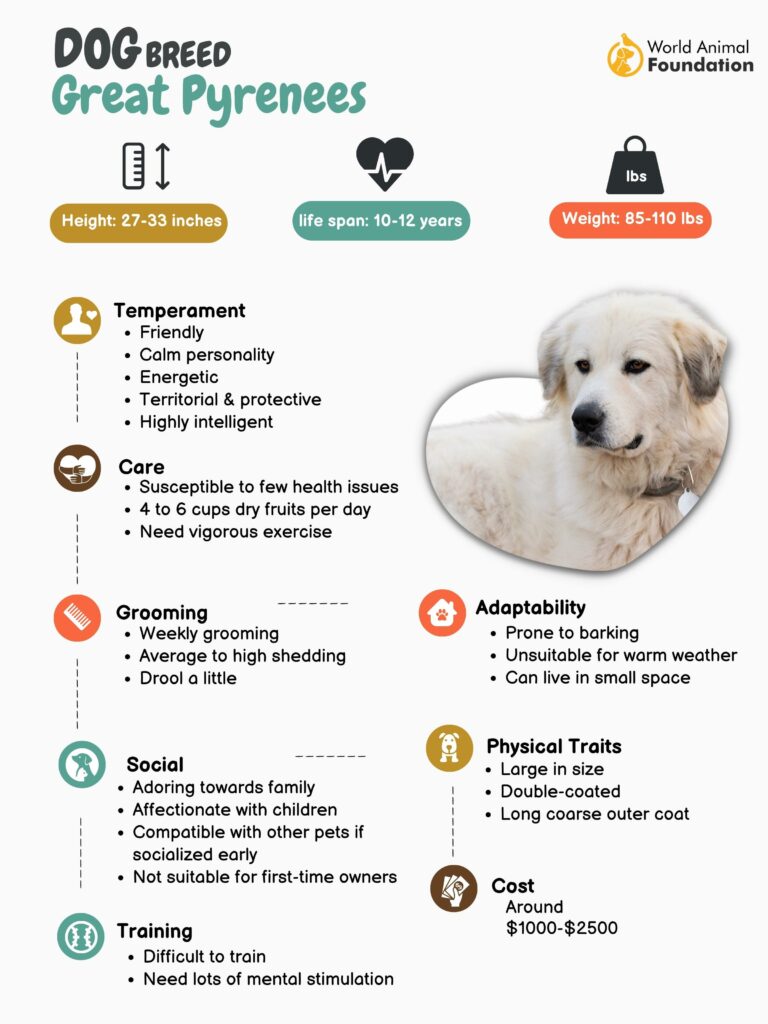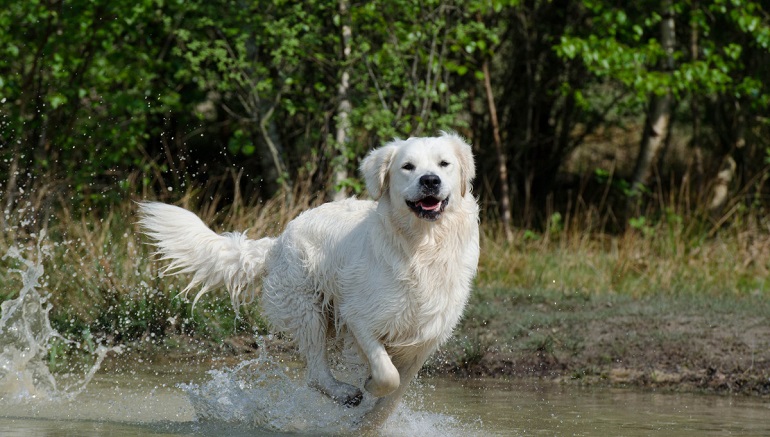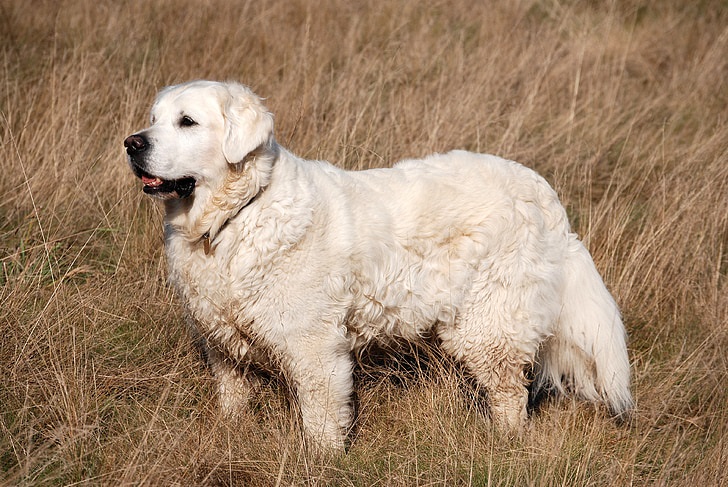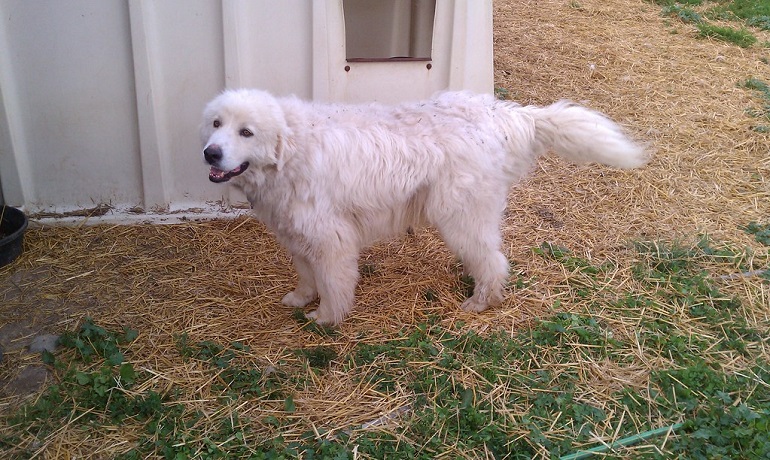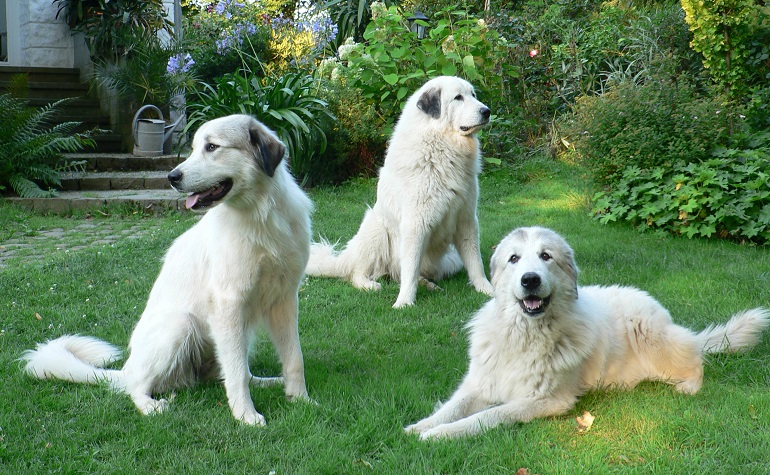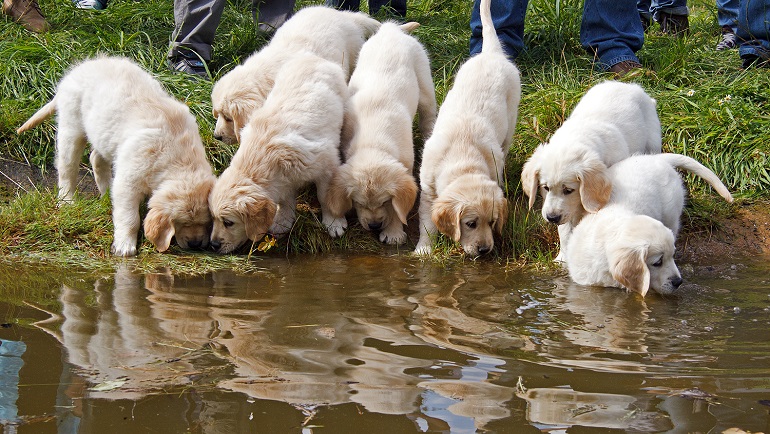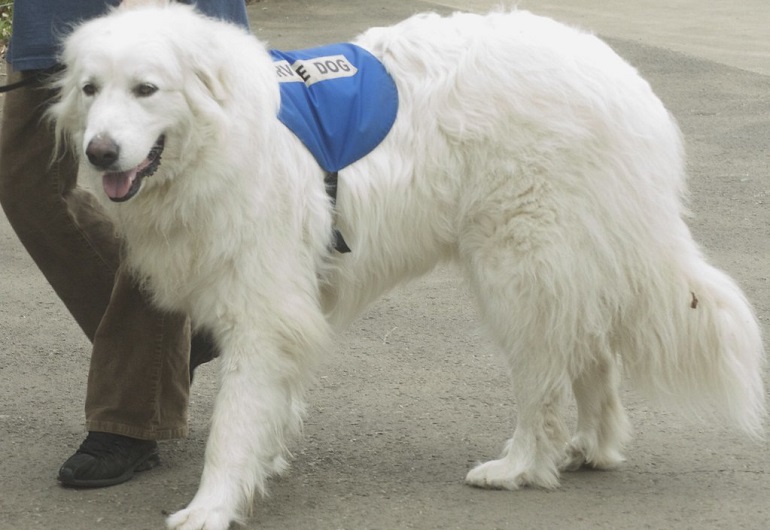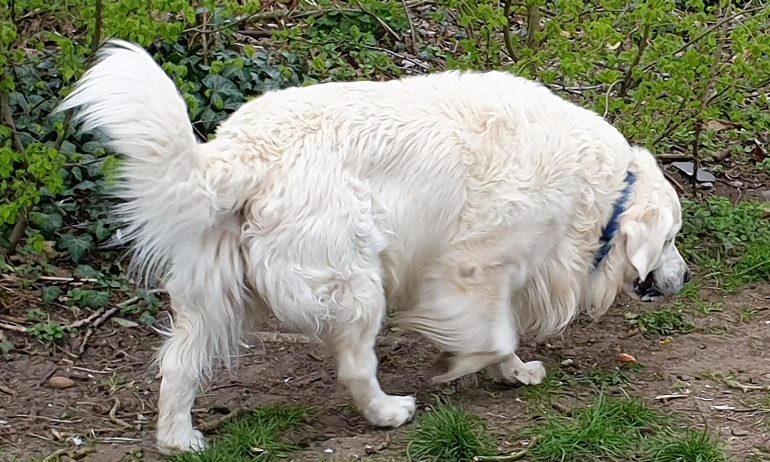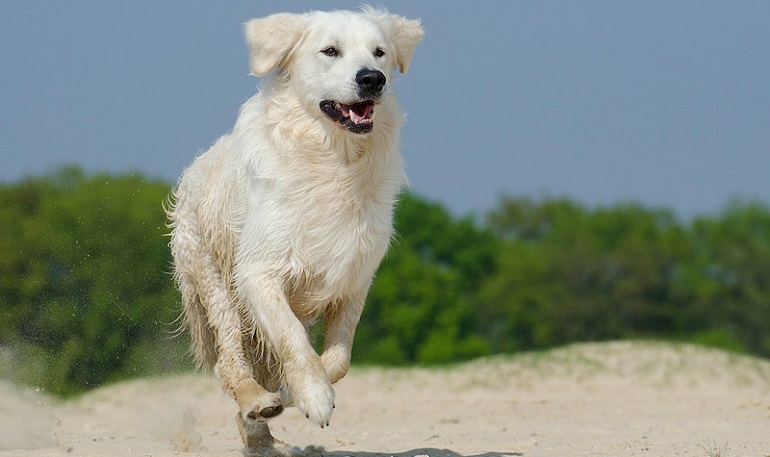The Great Pyrenees, a majestic and imposing breed, boasts a rich history as a livestock guardian. Beneath their impressive size lies a surprisingly gentle and fiercely loyal temperament. Understanding their unique traits, from their thick double coat to their independent nature, is key to successful ownership. This exploration delves into the core characteristics of the Great Pyrenees, offering insights into their temperament and providing practical guidance for training these magnificent guardians. Discover the rewarding experience of welcoming a Pyrenees into your life and learn how to nurture their protective instincts while fostering a harmonious relationship.
Every dog lover has dreamt about owning an ideal dog breed: vigilant, furry, intelligent, and shows keen enthusiasm greeting you at the door every day when you come home (extra emphasis on the “enthusiasm” part).
Well, in that case, we’ve got you covered! We might just have the perfect option for you that will potentially be your first option before you close the deal and buy your next furry best friend… presenting you: the Great Pyrenees Dog!
The Great Pyrenees is a native French dog breed originating from the Pyrenees mountains separating France and Spain, therefore also known as the Pyrenean Mountain Dog. This white, thickly coated, and the adorably gigantic creature is bound to melt the heart of any animal lover.
The Great Pyrenees are called Patou in their French homeland, closely related but not quite the same as its Spanish counterpart, Pyrenean Mastiff. They are known by their more common name Great Pyrenees, in America and the rest of the world and serve primarily as guardian dogs.
Originally bred for defense and to protect sheep, this special breed has its own unique set of skills, such as physical strength, protective nature, alertness, and power.
About the Breed
When listing some of the most sturdy, defensive, and large dog breeds in Europe and the rest of the world, it is unfair to leave out our humongous furry friend. The Great Pyrenees Dog is kept and known famously for its independent and protective instincts.
The Great Pyrenees possess an unmistakable physical appearance of solid white, thick, and double-coated fur. They are perfect for large households with many family members – owing to their affectionate nature towards children and other family members.
Apart from having good looks and brawns, the Great Pyrenees also have a distinct position in intelligence among guardian breeds and require mental stimulation. This intelligence gives an extra advantage to them when it comes to higher cognitive functions such as learning and training.
However, they are not easily trainable and don’t excel in obedience championships. Many dog experts credit this behavior to their independent thinking. They need obedience training and socialization from a young age.
There are slight variations when it comes to their physical appearance. Although many dogs belonging to the Great Pyrenees breed have an almost similar look, some tend to have a combination of outer coat colors such as pure white, white with some yellow patches, or gray.
Their outer fur is mostly straight or wavy, with their inner thick coat being soft and fine.
History of the Great Pyrenees
Each dog breed in the world has its unique history – having bred bearing a specific purpose in mind. And you can always – with factual accuracy – trace or guess the history of any dog breed by analyzing its purpose and appearance.
Considering the common purpose of all guard dogs and their similar histories, it would not surprise you that the Great Pyrenees were explicitly bred in their native land to protect flocks.
Although no one can claim to know the exact year when the Great Pyrenees originated, this breed is believed to be at least four to five centuries old.
Named after the natural border between Spain and France where the first Pyrenees came into existence – the Pyrenees mountains – this dog was bred to be robust and strapping enough to provide protection against formidable predators such as wolves, lions, and bears in ancient times.
Initially bred by peasant shepherds to guard their flocks and herding dogs in the coarse landscape of the Pyrenean mountains, the Great Pyrenees soon showed their usefulness and fortitude by looking out for sheep and deterring predators even in extreme living conditions such as freezing weather.
Due to its enduring patience and courage, the French nobility adopted the dog as the Royal dog of France in King Louis XIV’s court.
Great Pyrenees Facts
- Aside from having many qualities, this cute fur ball has many different names. Known commonly as The Great Pyrenees in the United States, this dog is called differently in its homeland; its French name is Le Chien des Pyrenees or Le Chien de Montagne. In UK and Europe, the same dog is called The Pyrenean Mountain Dog.
- The Great Pyrenees puppies have an abnormal growth rate. Within three months, the newborn puppies can grow up to thirty times their original weight – with an adult dog weighing as much as a hundred pounds.
- This one might not seem too unexpected, but the Great Pyrenees are about the same size as a wolf since their primary function was to deter off their less tamed, ancestral kin as livestock guardians.
- After this breed’s growing usage and popularity, the American Kennel Club recognized the Great Pyrenees in 1935, after which it got its own dog breed club: The Great Pyrenees Club of America. This exclusive breed club offers higher education, events, and competitions between Pyrenees and other breeds.
- Owing to their bulky physique, they are expected to need vigorous exercise, but this is not true! Moderate amounts of daily walks on a leash and some unleashed playing are enough for them.
- The Great Pyrenees tend to have nocturnal cycles or habits, as they like to patrol around the house, looking out for any potential danger (very true to their character). They also tend to bark a lot more than other dogs to warn you about any suspicion.
- Therefore, it is best to keep the Great Pyrenees inside at night so that you won’t have your neighbors complaining in the morning. This is one of the reasons they were also used in rescue groups.
Great Pyrenees Appearance
If you were to ask us to describe the appearance of the Great Pyrenees dog breed, we would wrap it all up by saying just one thing: the most adorable thing you have laid your eyes on! But let’s get on to doing it in more detail.
Great Pyrenees is a breed of giant and muscular dogs having a double coat and floppy ears. The thick coat on the top is usually rough and coarse in texture, consisting of long straight, or slightly wavy hairs.
The fur beneath it is the soft undercoat of thick, short, fine hair. The eye color of the Great Pyrenees is brown. However, variations are available from the breed standard in this aspect too.
Almost all dogs in this breed have white hair, but slight variations can be found in their fur colors. The most common colors found in the dog’s coat are pale yellow, gray, or tan.
The three-cornered ears of this fluffy creature just add to the overall look, and they are mostly drooping downward. The dog’s tail is plumed and reaches its hocks. The average height of this dog reaches up to 27-33 inches in males. The average life expectancy of a Great Pyrenees dog is ten to twelve years.
Size
Great Pyrenees belong to some of the largest breeds in terms of physical strength and dimensions. They have an ideal size for a guardian dog; however, some owners might not prefer that feature for a family pet.
Their height and weight vary significantly between the males and the females of the same breed. For example, the height of the Great Pyrenees is about seventy to eighty-two centimeters in males – while for females, the height can go as low as seventy-four to sixty-five centimeters.
Along the same lines, the weight also tends to vary. This difference in their heights and weights is normal and can be expected based on their genetic and metabolic differences. But too much deviance from the average size usually indicates bad nutrition, metabolic or genetic health problems, and you should consult a vet.
Weight
The weight of the standard breed of Great Pyrenees is calculated to be around forty-five to seventy-three kilograms in males or thirty-nine to fifty-two kilograms in females. But the weight of every individual dog can change depending upon several factors health, genetics, physical activity levels, and diet – as well as dog ages.
Given suggested levels of physical exercise and the recommended diet, a Great Pyrenees puppy can grow to the brawniest weight of around eighty kilograms! The Great Pyrenees are usually fully developed by the age of eighteen months, but they can also pick up weight after that.
So that is the time frame where you should be tracking your dog’s weight most keenly and immediately consult a doctor in case of any abnormality.
Coat
One of the most defining features of a Great Pyrenees dog is its double coat (we just cannot emphasize enough its majestic coat that is to die for). A watchful and courageous beast on the inside, yet a snowball of white fur on the outside, all thanks to its double coat of beautiful snow-white hairs.
The quintessential coat color of this dog is white, but some other colors in slight combinations are also found on its skin. It is double-coated and has a coarse long outer coat consisting of long hairs. The second coat beneath it is the soft inner coat, and it has fine, smooth, and short hair.
Caring for this lush, thick white fur can be a bit of a task for the new pup parents, who might expect high levels of grooming and caring for the Pyr’s fur. But this might not be entirely true! Their natural fur is relatively resistant to dirt and other damages, and it can make do with simple organic grooming shampoos.
The Pyrenees are one of the heavy shedders in the canine kingdom. Average Great Pyrenees shed a lot (you might want to minimize the color black in your wardrobe) – leaving trails of white fur everywhere in the house… It is best to use a tangle-resistant rake brush or a slicker and regular brushing to combat this snowstorm.
Bathing the dog once a month is enough, but your canine friend might appreciate fun bath times with you every once in a while.
Color
These white-colored, friendly babies come in all sizes and colors. Although the breed of Great Pyrenees is famous for its luxurious white outer coat, there is a range of available colors and their different combinations to choose from!
Most of the breed dogs range from white to cream in color, but some tend to have markings and patches of different colors on their bodies. Some Great Pyrenees have gray, reddish brown, dark brown, or tan markings on their tail, head, ears, or other prominent body parts.
However, there can be a few dark markings on your puppy that might fade away as they grow and mature. It is not an unnatural decolorization and is, in fact, part of the regular growth cycle of these dogs.
Great Pyrenees Temperament and Personality
“Looks can be deceiving.” This saying can best describe the dual nature of these deep-chested dogs.
Initially bred for the purpose of guarding livestock, this dog was made to sit in the freezing cold weather for days on end – doing nothing but watching keenly for any potential threat and attack if the said threat showed up.
These extreme conditions gave this dog breed a set of beneficial skills and qualities that set it apart as one of the best of its kind.
The Great Pyrenees’ temperament oozes love and affection. They are generally very friendly and affectionate towards kids and other members alike. Although originally raised in isolation atop snowy mountain valleys, this dog recognizes and bonds to its kin with unmatched loyalty.
However, having a past history as fierce guardian dogs, they can also be quite aggressive and protective if they sense any danger to the safety of their family. Having ties to their history, they can also be strong-willed; therefore, it is necessary to provide them with proper early socialization and obedience training.
Although going out to play is part of the plan with dogs, this dog breed is perfect for quieter households – thanks to their patient personality developed after years of service as watchdogs in hot and cool climates alike.
Great Pyrenees Health and Care
Like most breeds, these working dogs also have grooming needs and require constant care.
Care
Though Great Pyrenees are generally well-mannered and calm dogs, they can be pretty expensive and high-maintenance (we would not expect any less from the dogs of French nobility). Raising a Pyr is not too overwhelming, but you must properly tend to it to ensure it looks handsome and fits its standard.
The average life expectancy of a Great Pyrenees is 10 to 12 years, and they are susceptible to several health complications throughout their lifetime (but don’t let this influence your decision to bring this loveable giant into your house).
Generally, the Great Pyrenees are a well-mannered and disciplined breed of dogs – raised and trained in an environment demanding utmost patience and endurance. With minimal training and grooming, your handsome boy will bloom to his full potential as a healthy, intense, and happy doggo!
Being good at shedding, you should get ready to have abundant fur all over your house. Owning a slicker or rake brush is one of your go-to essentials when it comes to your dog’s grooming needs.
You should also not forget to trim your dog’s nails every two weeks. Very long nails can be painful for your dog, and you will know when it is time to trim them (they will clack-clack on the floor).
Health
When it comes to diet and nutrition, a balanced and nutritious diet can fulfill almost all of their health needs. The average, dry-dog food rich in protein usually is best for the Pyr and other breeds. However, you should calculate a personalized formula for your dog’s diet based on age, exercise, and general health.
Treats are an extra bit that you can add to their diet, which is fine as long as you don’t go too wild. Treats add extra calories to their diet, which can make them obese, which in turn invites health issues down the road, such as heart disease.
Lastly, this breed is susceptible to a few hereditary health problems, such as knee and hip dysplasia, patellar luxation, certain types of cancers, and neurological disorders. An annual medical checkup is necessary to keep track of your dog’s well-being and prevent any life-threatening condition.
When buying this dog, make sure to ask the breeder for health clearances and evidence that the pup’s parents had good qualities like excellent hip and elbow scores. Also, ask for a certification from the Canine Eye Registry Foundation to see that the dog doesn’t have any eye disorders.
Great Pyrenees Training
Training a Great Pyrenees dog is not an easy task, as has been reliably reported by several Pyr owners. Know that you are not alone in this, as this dog is known to be an independent thinker.
The best thing that you can do to train this bad boy is to establish a positive learning relationship between you and your dog, aka positive reinforcement.
Start by treating them to treats, praises, and playtime upon achieving even the tiniest milestones.
Another thing to consider while following such a routine is not to be repetitive; so your dog won’t look at you with sympathy and disdain. Instead, the trick is to set up training in several different settings instead of just always going to the same backyard.
Last but not least, remember to set realistic training goals with your Great Pyrenees dog. While it may be true that they are an intelligent breed, they are not like border collies or other dogs that excel at obedience trials or canine activities. Slowly and steadily, your dog will surely win the training race!
Conclusion
Having bred originally in the frosty summits of the Pyrenees mountains to act as a livestock guardian, the Great Pyrenees’ dog developed the most formidable and exceptional traits like intelligence, vigilance, power, and endurance.
It soon became the best of its kind in the canine kingdom and was adopted by the French nobility. Today, it is still recognized and appreciated in canine clubs as one of the best watchdogs.
And honestly, we can still go on and on about the pros of getting a Pyr dog, but we all know that in your heart of hearts, the decision has been made for you, and a little white fluffball is on its way to your life!
So without any further ado, buy a little Pyrenees puppy to turn your life more beautiful and lively.
Related Guide:
- English Bulldog
- Belgian Malinois dog
The Great Pyrenees, with their imposing size and gentle nature, make exceptional companions and guardians. Their inherent protectiveness, coupled with a calm and patient temperament, requires careful socialization and consistent training from an early age. While their independence can present a training challenge, their intelligence and loyalty allow them to thrive with positive reinforcement methods. A well-trained Great Pyrenees is a devoted, loving family member and a steadfast protector, enriching the lives of those fortunate enough to share their home with this majestic breed.


